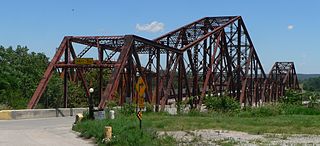
The Plattsmouth Bridge is a truss bridge over the Missouri River connecting Cass County, Nebraska, and Mills County, Iowa at Plattsmouth, Nebraska. Until 2014, it carried U.S. Highway 34 across the river.

The Jones County Courthouse in Anamosa, Iowa, United States was built in 1937. It was listed on the National Register of Historic Places in 2003 as the "Jones County Court House." It is a part of the PWA-Era County Courthouses of IA Multiple Properties Submission, and is the third building the county has used for court functions and county administration.

The Bridgeport Bridge was a historic structure located near Denmark, Iowa, United States. This span was a replacement bridge for the original structure whose middle stone pier was deteriorating. The weaknesses in the old bridge were noted in 1887 and 1893. Both Des Moines and Lee counties financed the $5,110 construction of this bridge, which spanned the Skunk River between the two counties. The 240-foot-long (73 m) Pennsylvania truss bridge was built in 1904 by the Clinton Bridge and Iron Works of Clinton, Iowa. It carried local traffic for nearly 90 years before it was closed.
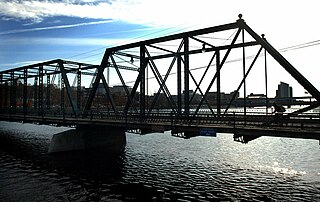
The Massillon Bridge Company, most commonly abbreviated Massillon Bridge Co., was located in Massillon, Ohio and founded by Joseph Davenport in 1869. The company became incorporated in 1887 and remained in operation through the early 1900s. Steel truss bridges built by the Massillon Bridge Co. can be found throughout the midwest.

The Hogback Covered Bridge is a historic covered bridge near Winterset, Iowa. Named after a nearby limestone ridge, it was built in 1884 by Harvey P. Jones and George K. Foster over the North River on Douglas Township Road. The 106-foot-long (32 m) bridge was designed with a Town lattice truss system. It was built with steel pylons to support the main span.

The Pine Mill Bridge is an historic structure located in Wildcat Den State Park in rural Muscatine County, Iowa, United States. It was built in 1878 near the Pine Creek Gristmill, the only place in Iowa where a mill and bridge combination remains in place. The bridge was listed on the National Register of Historic Places in 1998 as a part of the Highway Bridges of Iowa MPS.

The Upper Paris Bridge is a historic structure located near the town of Coggon in rural Linn County, Iowa, United States. The pin-connected Whipple through truss bridge was built in 1879 as a wagon bridge. It was designed by the Wrought Iron Bridge Company of Canton, Ohio. The bridge was listed on the National Register of Historic Places in 1998 as a part of the Highway Bridges of Iowa MPS.
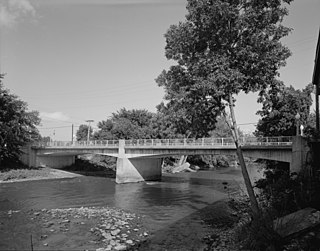
The Alden Bridge is a historic bridge in Alden, Iowa, which carries the town's Main Street over the Iowa River, United States. The concrete bridge is 150 feet (46 m) long and consists of two spans. It was built in 1936 to replace an earlier wooden bridge that had begun to deteriorate. The Weldon Brothers Construction Company supervised the bridge's construction, while the Iowa State Highway Commission designed the structure; it was one of the first bridges designed by the ISHC, which used similar plans for many other bridges in the state. Labor for the construction effort came from the Works Progress Administration, providing jobs for many of Hardin County's unemployed residents. The bridge was dedicated on July 4, 1936, as part of Alden's Independence Day celebrations.

The Wapsipinicon River Bridge is a historic structure located in Independence, Iowa, United States. It spans the Wapsipinicon River for 341 feet (104 m). The Buchanan County Board of Supervisors contracted with the Miller-Taylor Construction Company from Waterloo, Iowa, to build the new bridge on the south side of Independence for $37,680. However, high water created problems during construction, and the bridge was completed in January 1927 for $57,530. It replaced an earlier two-span iron truss bridge. This bridge is a concrete filled spandrel arch bridge with four spans. It was designed by the Iowa State Highway Commission, and continues to carry vehicle traffic. The bridge was listed on the National Register of Historic Places in 1998. There is a similar bridge upstream in Independence that was built in 1918.

Nodaway River Bridge is located west of Grant, Iowa, United States. It spans an arm of a small pond in Pilot Grove County Park for 70 feet (21 m). The Montgomery County Board of Supervisors accepted a petition from S. M. Smith to build a bridge over the Nodaway River south of Grant in June 1876, and another bridge over the Nishnabotna River at the same time. The county contracted with the Missouri Valley Bridge & Iron Co. of Leavenworth, Kansas, to design and build the Nodaway River bridge, which was completed later the same year for $1,000. The bridge consists of a single-span Bowstring arch-truss with a wood deck. It remained in use as a road bridge until 1968, when it was moved to the park for use as a pedestrian bridge. Even though it is no longer in its historic location and used for its historic function, the bridge was listed on the National Register of Historic Places in 1998 as an example of early transportation development in Iowa.
The Okoboji Bridge is located southwest of Milford, Iowa, United States. The 83-foot (25 m) span carried traffic on 180th Avenue over a branch of the Little Sioux River. The Dickinson County Board of Supervisors hired a local contractor to build a bridge across the straits between East and West Okoboji Lakes in 1859. The wooden structures had to be rebuilt in 1874–1875. There was a desire for a drawbridge at this point to allow for steamboats to navigate between the lakes. Three different swing spans were built at this location in the 19th century. When the third span deteriorated the board of supervisors contracted with the Clinton Bridge and Iron Works of Clinton, Iowa to build a permanent span here in June 1909. The Pratt/Warren pony truss structure was completed later that year for $1,550. The bridge and the road were incorporated into the U.S. Highway System, and it was placed under the aegis of the Iowa State Highway Commission. In 1929 it was replaced with a fixed-span concrete girder structure. At that time the 1909 truss span was moved to Okoboji Township to span a branch of the Little Sioux River. It was listed on the National Register of Historic Places in 1998. The span has subsequently been abandoned.

Red Bridge is a historic structure located northeast of Postville, Iowa, United States. It spans the Yellow River for 128 feet (39 m). The Allamakee County Engineer designed the timber Pratt through truss structure, and it was erected by a local contractor named A. L. Powell in 1920. Built for $2,304.74, it is composed of timber compression members and forged iron tension members. The structural steel was provided by the Worden-Allen Company of Milwaukee, and City Lumber provided the timbers. At some point it was abandoned and the timber deck and stringers were removed. It is the last uncovered timber truss bridge remaining in Iowa. The bridge was listed on the National Register of Historic Places in 1998.

The Elkader Keystone Bridge is a historic structure located in Elkader, Iowa, United States. The old iron truss bridge that crossed the Turkey River at this location was declared unsafe in 1888. The Clayton County Board of Supervisors decided to construct a bridge of native limestone as way of saving money and providing a reliable crossing. Engineer M. Tschirgi designed the structure and Dubuque stonemasons Byrne and Blade constructed the bridge. It was built at a cost of $16,282, and spans the river for 346 feet (105 m). This is one of the largest twin arched keystone bridges west of the Mississippi River. A sidewalk was added on the north side of the structure in 1924. The bridge was individually listed on the National Register of Historic Places in 1976.
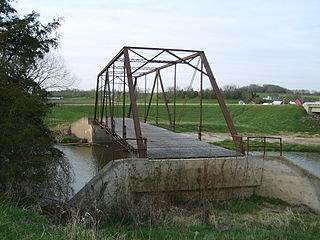
Mill Race Bridge is a historic structure located northwest of Eldorado, Iowa, United States. It spans the Turkey River for 120 feet (37 m). Its name is derived from its location near a riverside mill. Horace E. Horton, a civil engineer from Minneapolis, had designed wagon bridges for Fayette County in the 1880s. When he joined the Chicago Bridge & Iron Company late in the decade, he took the county with him as a client. Chicago Bridge & Iron was responsible for providing the county's bridges in the 1890s. This bridge was completed about 1892, but its concrete abutments are not original. While it remains in place, but it has been replaced by a newer span. The Mill Race Bridge was listed on the National Register of Historic Places in 1998.

Hale Bridge is a historic structure located south of Anamosa, Iowa, United States. It spans the Wapsipinicon River for 296 feet (90 m). It is an example of a bowstring through-arch truss bridge. Perhaps thousands of these bridges were built in Iowa in the late 1860s through the 1870s. However, by 1992, fewer than twenty survive.
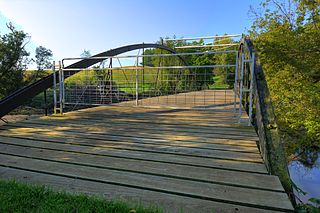
Lower Road Bridge is a historic structure located northwest of Anamosa, Iowa, United States. It spans Buffalo Creek for 160 feet (49 m). The King Iron Bridge and Manufacturing Co. of Cleveland erected a bowstring through arch truss and a shorter pony arch in 1878 for what was historically called Lower Road. The bridge's superstructure consists of a large stone masonry pier and abutments. It was listed on the National Register of Historic Places in 1998. The county abandoned the bridge and it is now privately owned.
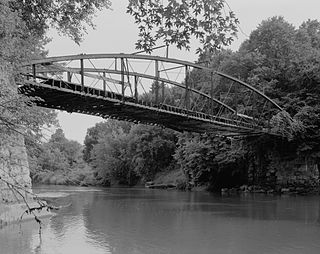
Corbett's/Eby's Mill Bridge is a historic structure located northeast of Scotch Grove, Iowa, United States. It spans the Maquoketa River for 128 feet (39 m). James S. Applegate established a gristmill near this location in 1858. He was joined by John Corbett, who obtained ownership by 1868 and expanded the operation and added a sawmill. He petitioned the Jones County Board of Supervisors for an iron bridge at this location in 1870. They agreed to pay two-thirds of the construction costs with the final third paid for by local subscriptions. The contract to construct this bridge and a similar span in Monticello was made with Miller, Jamison & Company of Cleveland. Both are single span bowstring truss bridges that were completed in November 1871. This bridge has always been identified with the mill. Samuel Eby acquired it in 1875, and it remained in the family until 1913. The bridge was originally on a loop road that circled behind the mill pond. When County Road X73 was created in 1958 it bypassed the bridge to the south. The bridge has been under private ownership ever since. It was listed on the National Register of Historic Places in 1985.

The Winnebago River Bridge was a historic structure located north of Mason City, Iowa, United States. The span carried U.S. Route 65 over the Winnebago River for 122 feet (37 m). This is the second span at this location. The stone abutments from the previous bridge were utilized in this one. They were sheathed in concrete by the Concrete Engineering Company, and William Henkel of Mason City constructed the bridge. It is composed of three concrete spans with a 70 feet (21 m) center span cantilevered from shorter anchor spans. It was listed on the National Register of Historic Places in 1998. A second span has subsequently been built to the east in 1969.
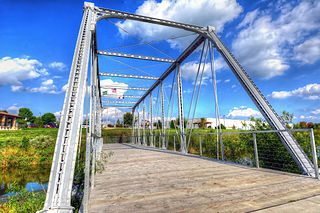
The Dunleith and Dubuque Bridge, also known as the White Water Creek Bridge and the Bergfeld Recreation Area Bridge, is a historic structure located in Dubuque, Iowa, United States. This span was part of a seven-span approach to one of the first bridges constructed over the Mississippi River. It was part of a railroad bridge that connected Dubuque with Dunleith, Illinois, now known as East Dubuque. The bridge was fabricated by the Keystone Bridge Company of Pittsburgh, Pennsylvania. Andrew Carnegie himself traveled to Dubuque to advocate for his company to build the bridge. The bridge was erected by Reynolds, Saulpaugh and Company of Rock Island, Illinois. The approach, of which this iron truss was a part, was completed in 1872. It was used by the Illinois Central and other railroads.

Keigley Branch Bridge is a historic structure located northeast of Gilbert, Iowa, United States. It spans the Keigley Branch for 47 feet (14 m). The Iowa State Highway Commission was re-formed in 1913 and they developed standard designs for smaller bridges. One of their designs was an alternative to the Luten arch. They were built throughout the state in the 1910s and 1920s. This is the oldest remaining arch bridge from that era. The Koss Construction Company of Des Moines completed it in 1913 for $3,384.85. The bridge features a medium-span arch with concrete-filled spandrels, paneled guardrails, a corbeled arch ring, and two-tone concrete detailing. The Keigley Branch Bridge was listed on the National Register of Historic Places in 1998.





















